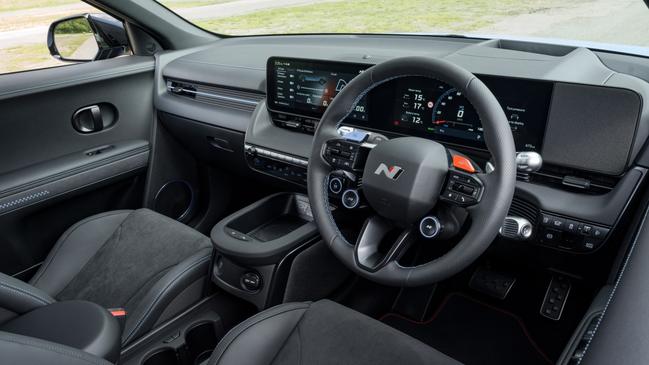
Well, he was as good as his word, and a few weeks later the Ioniq 5 N whooshed into my drive. And I was as good as my word. I didn’t drive it.
Over the following few days, though, I was forced to admit my new garden ornament was quite striking. This is something I find slightly annoying. With the obvious exception of Tesla, electrical cars are usually much better looking than proper cars. Polestar springs to mind here. And there’s a Volkswagen that looks like the sort of thing Martin Landau should have used in Space: 1999. It’s as if all the bright young things are working on EVs and all the crusty old dinosaurs are kept on to churn out the cars that, er, people want to buy.
The Hyundai Ioniq 5 N looks like a Golf that’s been designed by someone who was fired by Lamborghini for being too mad. It looks very good indeed. But it weighs more than two tonnes and that’s not acceptable. Not in a car that’s supposed to be a seat-of-your-pants, trousers-on-fire, tyre-shredding hot hatchback.
Anyway, I can’t remember why but one day I did drive the Ioniq and, to begin with, it was the usual dreary blend of tyre noise and meaningless hieroglyphics on the dashboard. I literally don’t know what a kilowatt is. But then I put my foot down and, sweet Jesus, it was fast. Not Ferrari fast. Much, much faster than that.
It may weigh more than Robert Maxwell, but it set off like Usain Bolt after someone had just given him a wasabi enema. Of course a lot of electrical cars can do this party trick, but only in very short bursts. In the Ioniq the thrust just keeps on coming. And that’s because it has two motors. The one driving the front wheels is giving you 166kW and the one driving those at the back 282kW. That’s 448kW in total, and for ten-second bursts it can deliver 30kW more. I have no idea what the 0 to 100km/h time is because no equipment is sensitive enough to measure such a short time-frame (the people at Hyundai say 3.4 seconds). But I can tell you that flat out you’ll feel like what you are: a meat-coated skeleton, made of stardust, that’s sitting on a rock as it hammers through space at 600,000km/h.
And then you get to a corner, and because it has four-wheel drive and the tyres are wider than even me, you just whizz round and then you’re back on the straight and your face is peeling off again. It is hilarious. Unless you want it to be boring or frightening. Because here’s the thing: the Ioniq comes with a vast range of options so that no matter the circumstances or driver, there’s a mode to suit.

There’s even a mode you can engage to do a lap of the Nürburgring, the famous race track in Germany. This actually reduces the available power slightly because, Hyundai says, that’s the only way you can get back to the pits without ending up in a puddle of melted lithium.
Then you have the Drift mode. This moves the power delivery between the front and rear to ensure you can create a smoky whirlpool and sit in it until you realise that all the onlookers have decided you’re a loony.
I pushed one button marked NGB, which I subsequently learnt stands for “N Grin Boost”, and nothing happened. Except that in the top right corner of the dash a small countdown began. As I was approaching a junction this was very scary. What would happen when the clock ticked down to zero? Would there be an explosion? Would I take off? The answer is nothing happened. So that was both a relief and a bit of a disappointment.
So I pushed another button and suddenly the cabin was filled with engine noise. And when it reached the top of the make-believe rev range, I pulled one of the paddles and there was a jerk like it had shifted gear. None of this is real. There is no gearbox in an electrical car, and the noise is artificially produced. It is a fun feature. But soon I turned it off and went back to listening to the tyres.
Last week, for complicated reasons, I was looking back over some of the road tests we did on Top Gear and The Grand Tour, and only a couple of years ago we were raving about how the Ford Focus RS would send as much power as possible to the wheel with the most grip, and how Nissan had filled the GT-R’s tyres with helium for extra lightness. The whole industry was engaged in a battle to see who could use clever engineering to extract as much speed as possible from their cars. Double-clutch gearboxes were being developed to make gearshifts happen in an instant, and electronic differentials were constantly being improved so a car could corner like an elephant shrew (see YouTube for details).
Then it all stopped. Cars started to get slower. Today they accelerate more pathetically than they did in 1975, and thanks to legislators they are all now fitted with so many warning bongs that only the profoundly deaf could actually enjoy driving one.
So this Hyundai is a breath of fresh air. You get the sense that it really has been made to be as much fun as is humanly possible. It’s welded together more firmly and engineered to cope with the prodigious power. So I’m glad the man from Hyundai sent it round and I’m glad I drove it.
But there’s no getting round the fact that its fake gearbox and its fake engine noise and all the electronic trickery needed to make it drift are there to mask the fact that it’s an electrical car. You may be the sort of person who finds all this amusing and you’d be very happy with a car that can be tuned to suit your mood. I wish you well, but I should warn you that there are a couple of real-world problems. Thanks to a lousy turning circle and a sticky hill-hold facility, it’s very difficult to park. Oh, and it costs a whopping $111,000.
Hyundai Ioniq 5 N
ENGINE: Two electric motors, 84kWh battery
PERFORMANCE: 0-100km/h 3.4 seconds, top speed 258km/h
PRICE: $111,000
JEREMY’S RATING:★★★★






I recently met a man who works for Hyundai, and he was most insistent that I would like his company’s new electrical hatchback. I explained that I wouldn’t because electrical cars bore me. “This one won’t,” he argued. “Yes it will,” I countered. So he said he’d send one round for me to try, and I said that would be a waste of time because I wouldn’t drive it.